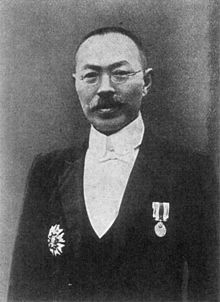| Shiratori Kurakichi | |
|---|---|
 | |
| Born | (1865-03-01)March 1, 1865 Mobara, Chiba, Japan |
| Died | March 30, 1942(1942-03-30) (aged 77) Chigasaki, Kanagawa, Japan |
| Other names | 白鳥 倉吉 |
Shiratori Kurakichi (白鳥 庫吉, March 1, 1865 – March 30, 1942) was a Japanese historian and Sinologist who was one of the pioneers of the field of "Oriental History".
Biography
Shiratori graduated from Tokyo Imperial University and joined the staff of Gakushūin University in 1890. He later returned to Tokyo Imperial University where he became a professor. Kurakichi had, at one time, studied under Ludwig Riess, who was himself a former student of Leopold von Ranke. In 1905, he founded the Asia Research Society (亜細亜学会 Ajia Gakkai).
Writings
Japanese history
Beginning in 1910, Kurakichi was one of several historians who argued that the previously high value placed on female state and military leaders in Japanese history should be reduced as all of them, such as Himiko and ancient Japanese empresses, were, in Kurakichi's estimation, merely religious leaders concerned with performing rites and not leaders with actual administrative power.
East Asian history
In addition to domestic Japanese history, Kurakichi has also been identified as a leading pioneer of "oriental history" (東洋史 Tōyōshi) studies in Japan by focusing on the unique history of East Asia and Japan's place in it, such that Kurakichi and like-minded historians could "create a realm that would allow the assertion of an identity at once distinct from and equal to the West." The writer Stefan Tanaka has argued that this process involved removing the traditional stress on Chinese civilization as the centre of East Asians' understanding of their own history, and instead treating seminal Chinese icons such as Confucius as representatives of "East Asian" history more broadly. This would allow, for instance, equality between Confucian China and Confucian Japan as two parts of a shared oriental history, and so on. Furthermore, this would also allow modern East Asian history to be framed in such a way as to have Japan as the leading nation instead of China, as had been common in the past, and, by 1918, he had argued that it would be best for China to be administered by Japan. This framework would allow Japan to be seen as a culturally superior nation and thus on par with the great European powers of the day. Moreover, Kurakichi, like most Japanese nationalists of his day, equated the people with the state and believed that history should be used to bolster the state.
Kurakichi's interests stretched to include much of Asian beyond only China. Kurakichi has been identified as a pioneering Koreanist, and had been studying the historical linguistics of the Korean language and supported the Altaic hypothesis as early as 1905. He was also interested in Manchurian regional history as early as 1913, and argued for the view of Korea and Manchuria as being historically interconnected and inseparable. He wrote on the topic of the ancient Balhae state and noted the presence of both Chinese and non-Chinese sounding names in records of Balhae emissaries, interpreting this as a marker of ethnic diversity between Goguryeo Koreanic and Mohe individuals respectively.
Kurakichi had argued that the Liugui land described in ancient Chinese records was Sakhalin and that it was inhabited by Ainu people.
Relatives
- Nephew:Toshio Shiratori(白鳥 敏夫) was the Japanese ambassador to Italy from 1938 to 1940, adviser to the Japanese foreign minister in 1940, and one of the 14 Class-A war criminals enshrined at Yasukuni Shrine.
References
- ^ Calichman, Richard, ed. (2005). Contemporary Japanese Thought. Columbia University Press. p. 300. ISBN 978-0-23150988-6.
- Kang, Sangjung (2005). "The discovery of the 'Orient' and Orientalism". In Calichman, Richard (ed.). Contemporary Japanese Thought. Columbia University Press. pp. 84–100. ISBN 978-0-23150988-6.
- ^ CHANG, Wonsuk (2018), AMES, ROGER T.; HERSHOCK, PETER D. (eds.), "Euro-Japanese Universalism, Korean Confucianism, and Aesthetic Communities", Confucianisms for a Changing World Cultural Order, University of Hawai'i Press, pp. 222–234, ISBN 978-0-8248-7258-8, retrieved 2022-02-03
- Yoshie, Akiko; Tonomura, Hitomi; Takata, Azumi Ann (2013). "Gendered Interpretations of Female Rule: The Case of Himiko, Ruler of Yamatai". U.S.-Japan Women's Journal (44): 3–23. ISSN 2330-5037.
- Schmid, Andre (2000). "Colonialism and the `Korea Problem' in the Historiography of Modern Japan: A Review Article". The Journal of Asian Studies. 59 (4): 951–976. doi:10.2307/2659218. ISSN 0021-9118.
- Shih, Chih-yu (2011). "A Rising Unknown: Rediscovering China in Japan's East Asia". China Review. 11 (1): 1–26. ISSN 1680-2012.
- ^ An, Jinsoo (2010). "The Ambivalence of the Nationalist Struggle in Deterritorialized Space: The Case of South Korea's Manchurian Action Film". China Review. 10 (2): 37–61. ISSN 1680-2012.
- Saaler, Sven (2007). "The Construction of Regionalism in Modern Japan: Kodera Kenkichi and His "Treatise on Greater Asianism" (1916)". Modern Asian Studies. 41 (6): 1261–1294. ISSN 0026-749X.
- Bai, Yunfei (2017). "The Writing of the Unwritten and the Translation of the Untranslatable: Alexnadra [sic] David-Néel's Reception in China". Comparative Literature Studies. 54 (2): 406–430. doi:10.5325/complitstudies.54.2.0406. ISSN 0010-4132.
- Miller, Roy Andrew (1998). "KOREAN EVIDENCE FOR THREE EURASIAN—ALTAIC "WANDERWÖRTER" SCENARIOS". Acta Orientalia Academiae Scientiarum Hungaricae. 51 (3): 267–296. ISSN 0001-6446.
- Schneider, Julia (2011). "The Jin Revisited: New Assessment of Jurchen Emperors". Journal of Song-Yuan Studies (41): 343–404. ISSN 1059-3152.
- Nickel, Lukas (2013). "The First Emperor and sculpture in China". Bulletin of the School of Oriental and African Studies, University of London. 76 (3): 413–447. ISSN 0041-977X.
- Trekhsviatskyi, Anatolii (2007). "AT THE FAR EDGE OF THE CHINESE OIKOUMENE: MUTUAL RELATIONS OF THE INDIGENOUS POPULATION OF SAKHALIN WITH THE YUAN AND MING DYNASTIES". Journal of Asian History. 41 (2): 131–155. ISSN 0021-910X.